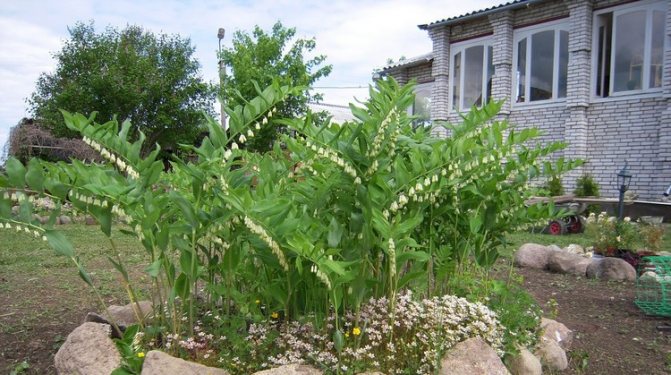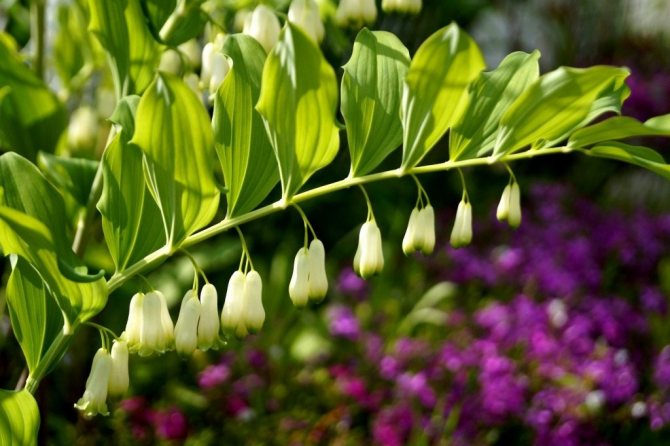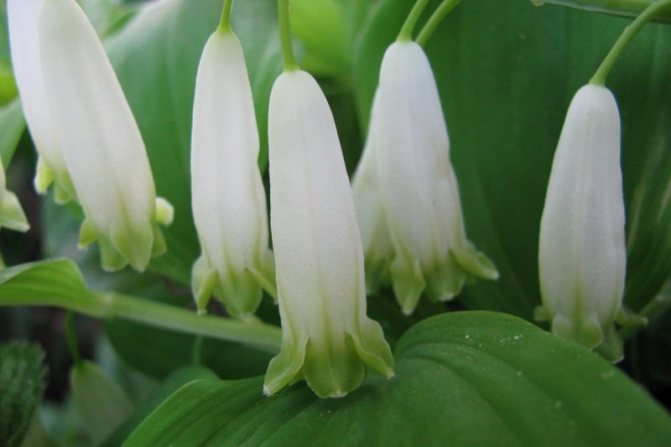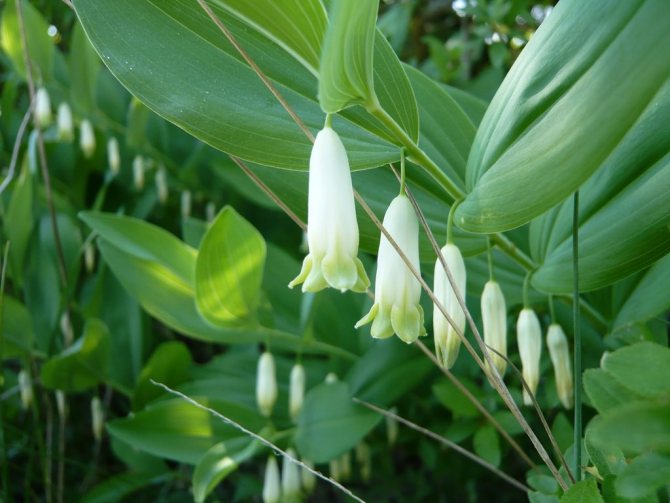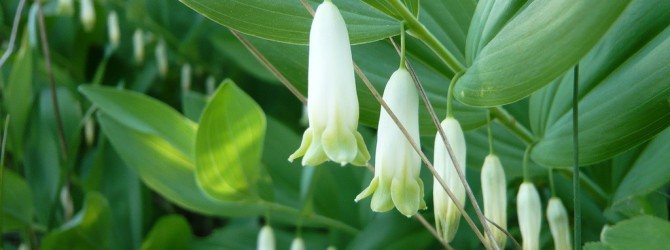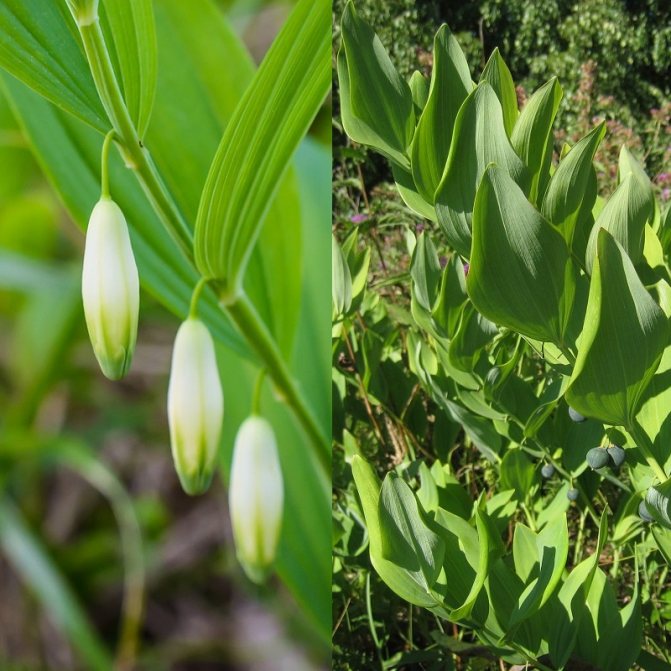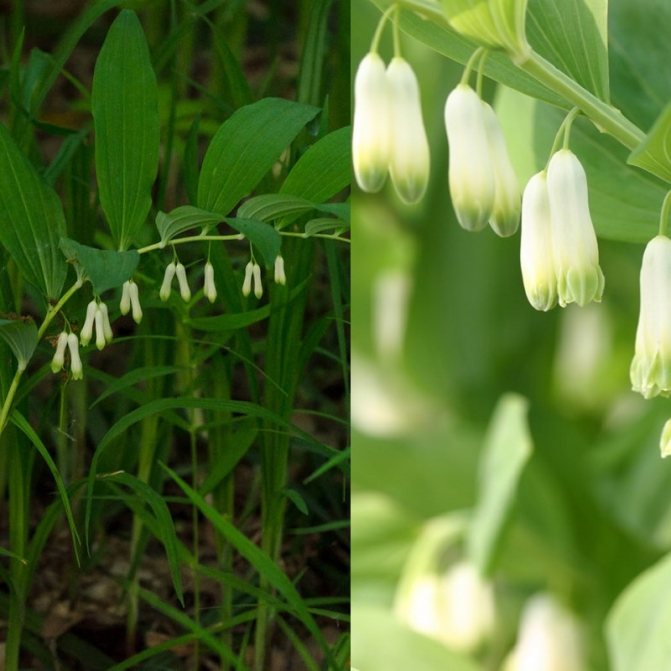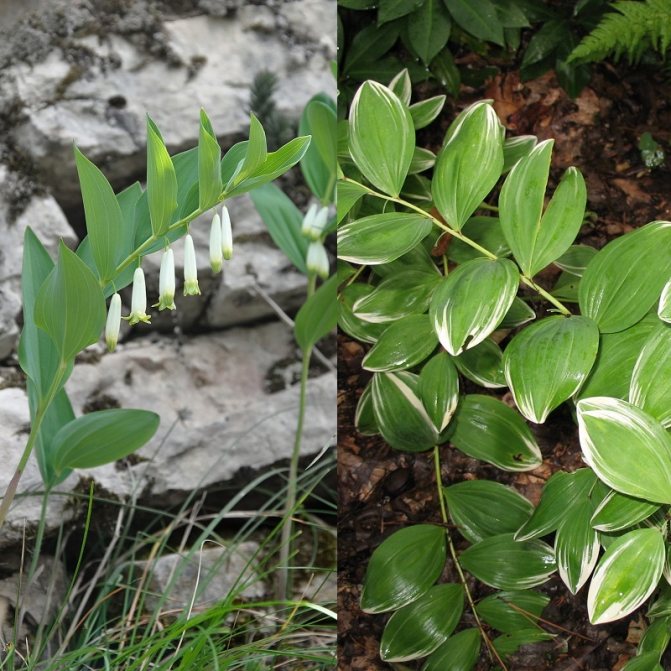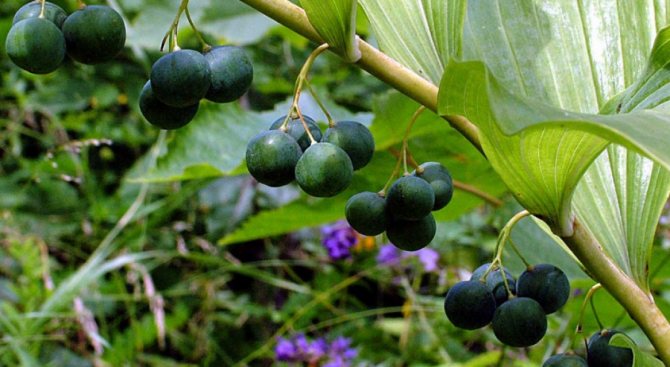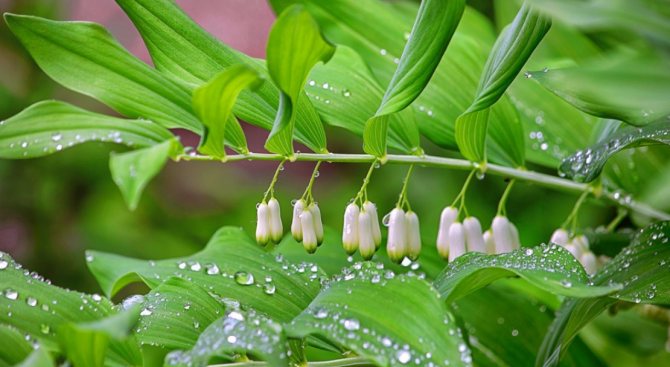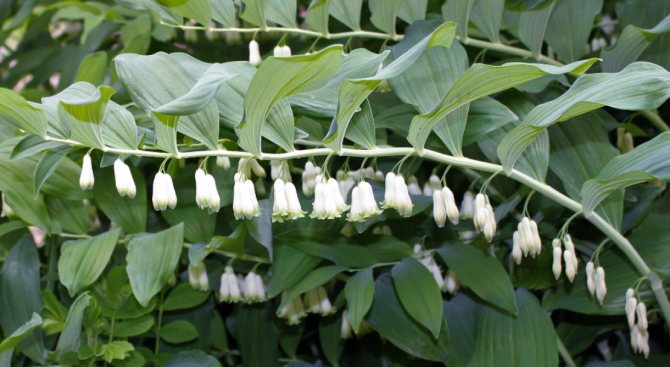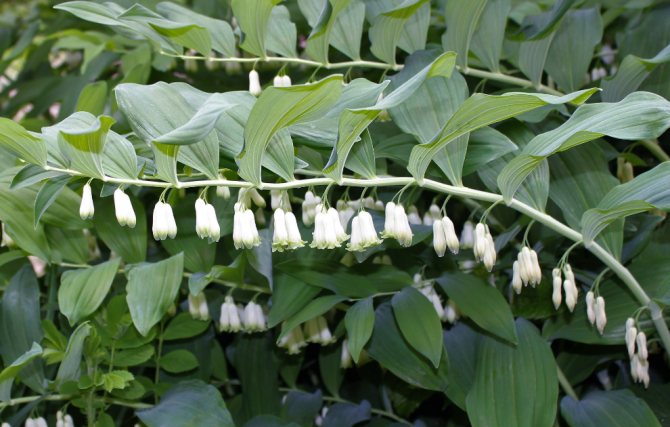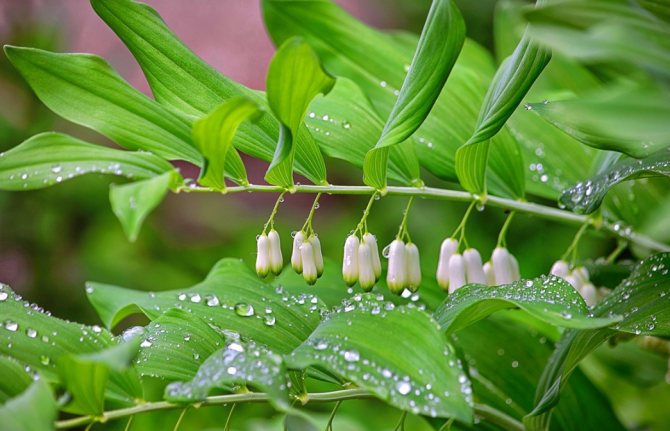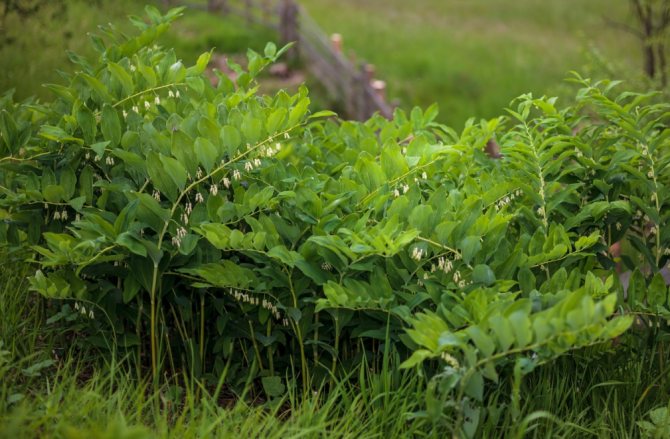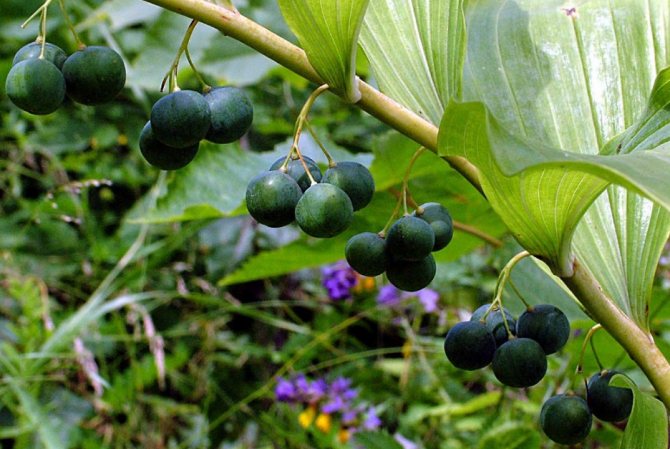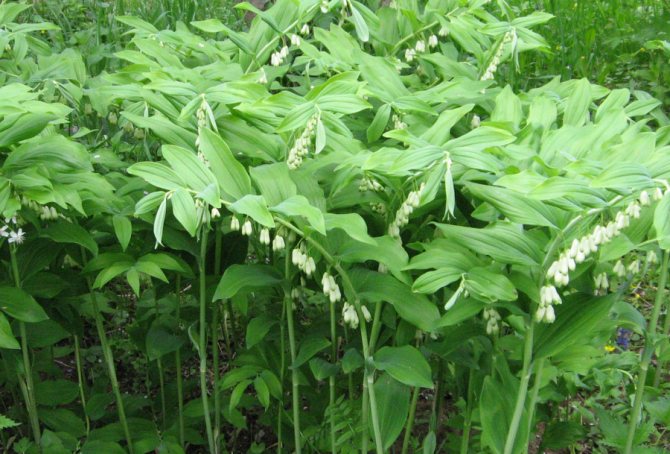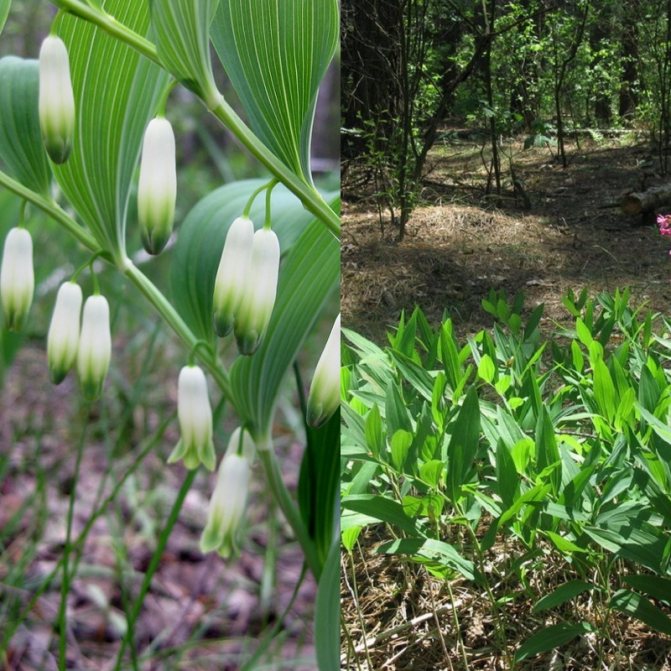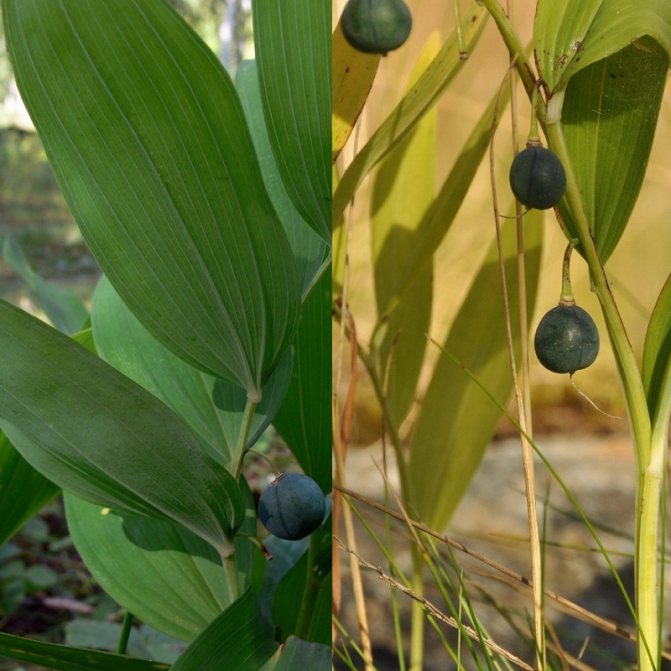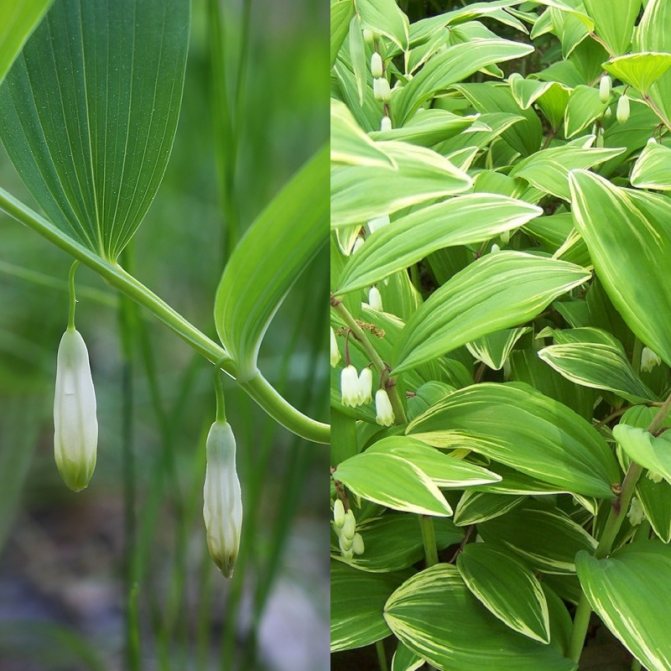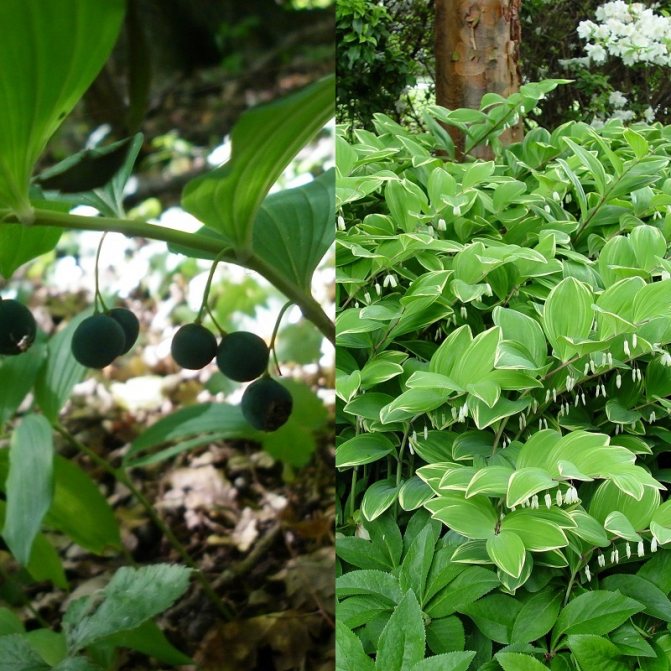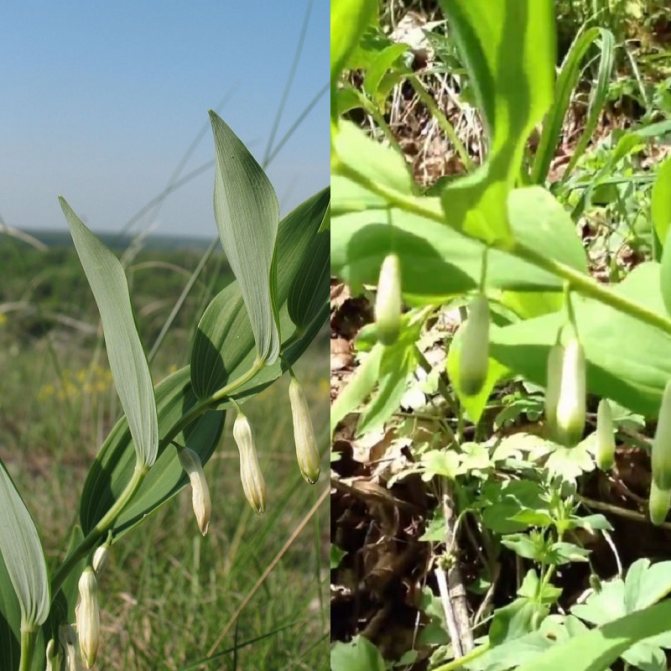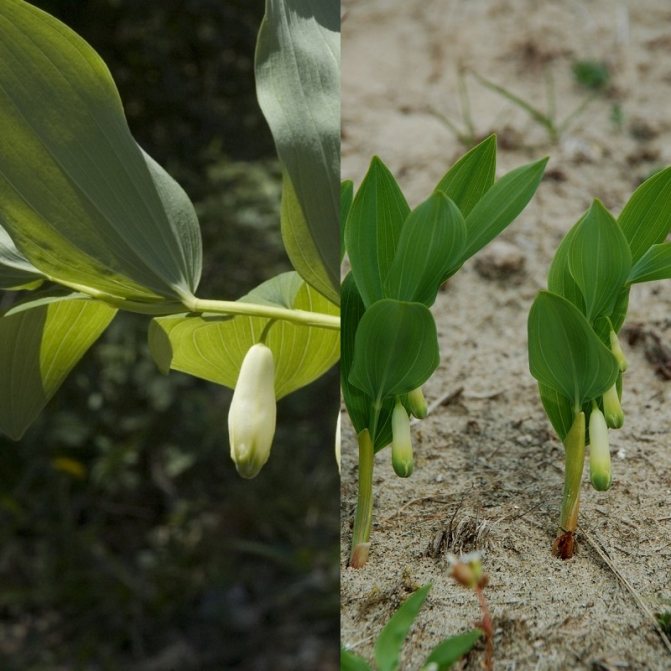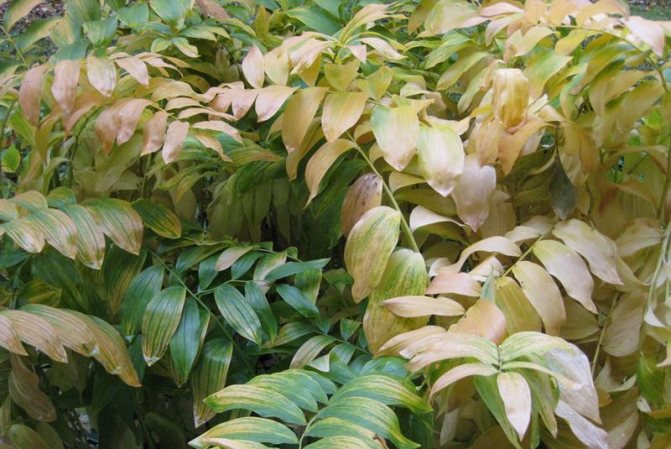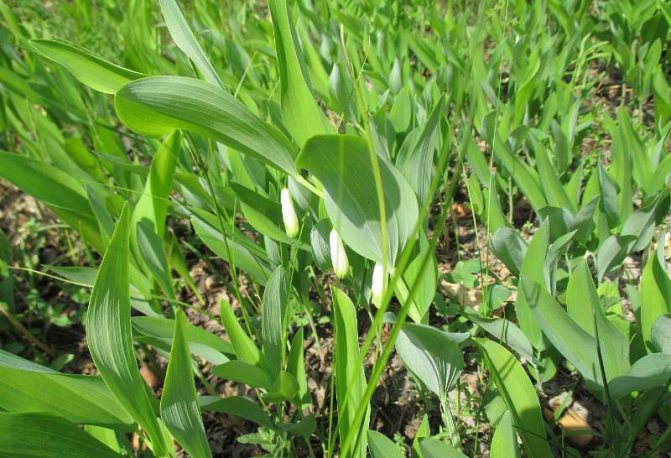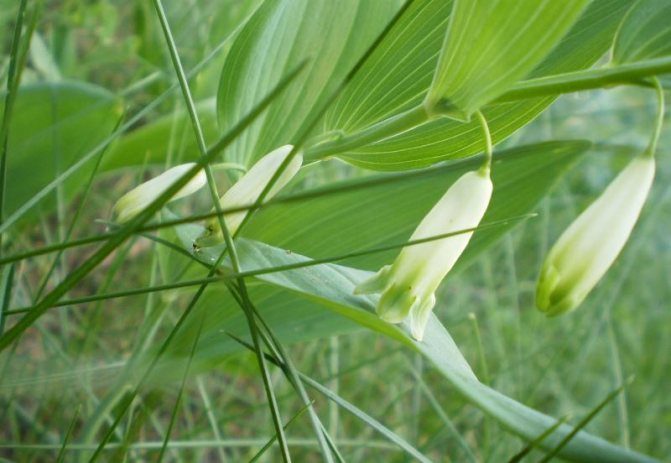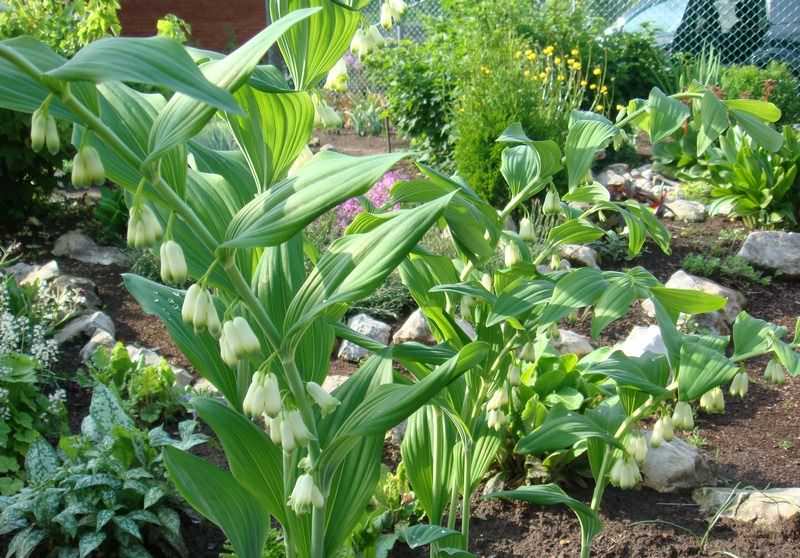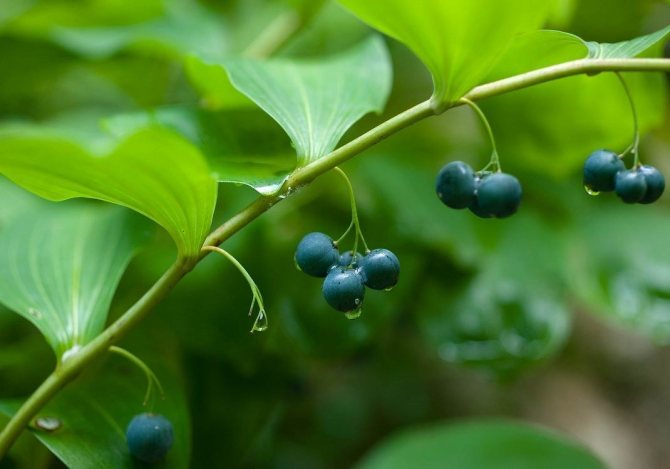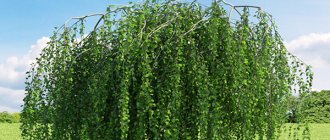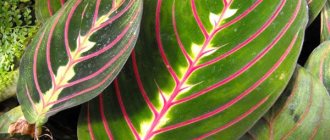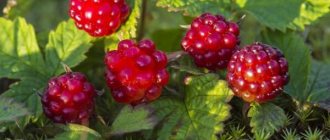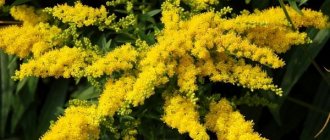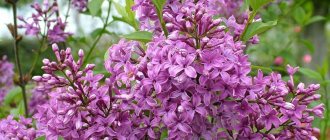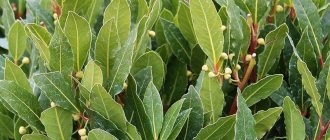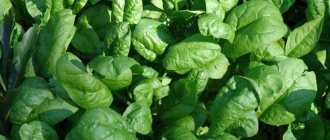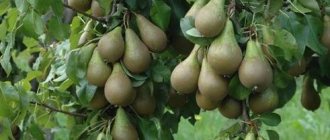A medicinal or pharmacy flower is a poisonous plant, therefore, when grown from seeds or rhizomes, plantings are located on the site in such a way that children and animals have access to them. Polygonatum officinale has many beneficial properties, many of which are described in detail in this material.
Here you can familiarize yourself with the agricultural technology. It is told about planting purchased and leaving in the open field - from the moment of sowing seeds to technical maturity, at which it is possible to collect medicinal raw materials.
Read the description of the flower bought and see the numerous photos located on the page:
Description of the purchase
Kupena is found in the forests of the Northern Hemisphere. The small white flowers of the perennial make it look like a lily of the valley, and are bell-shaped, the peduncles are flexible. White petals closer to the edges are colored green. The buds are arranged in whorls in the axils of the leaves, 1–4 pcs. Flowering occurs in May - June. The floral scent is pleasant and very intense.
Flowers are pollinated mainly by bumblebees, less often self-pollination occurs. In the period from July to August, the fruits of the kupena ripen - round, bluish-black berries, each of which contains 1-9 seeds... Large ovoid leaves grow in whorls of 3-9 pcs. Stems are long, arched. The genus has several dozen species. Depending on the species, the height of the plant reaches from 10 cm to 1.5 m. The length of the leaves is 4–10 cm, the width is 2–5 cm.
Poisonous plant or not
Kupena has healing properties and is used as a medicine. However, the plant is considered poisonous. Given this fact, it is necessary to separately identify contraindications for use.

It is strictly forbidden to use all parts of the plant (roots, leaves, fruits) by persons under the age of majority, as well as by women during pregnancy and lactation.
- Also, contraindications include intolerance to the components that make up the plant, such as:
- alkaloid glyconine;
- cardiac glycosides;
- steroidal saponins;
- tannins;
- chelidonic and ascorbic acids;
- asparagine;
- glucose;
- carotene.
Does the purchased rhizome
The aforementioned underground organ of the Kupena has a woody structure. Branching roots grow horizontally and are located close to the surface of the earth - in the upper layers of the soil. On the knotty rhizome there are round "seals" - traces of dead stems, which are formed from numerous root points of growth.


Chemical composition
Leaves and stems contain:
- up to 1% diostegin - steroid saponin;
- alkaloids;
- quercetin, vitexin - flavonoids, P-vitamin.
The active composition of the rhizome:
- slime;
- starch;
- ascorbic acid, carotene;
- glucose, fructose - natural sugar, processes carbohydrates;
- nitrogen compounds;
- tannins;
- zinc, manganese, copper, etc. - trace elements;
- cardiac glycosides.
Types of purchased
The genus has about 50 species. Ornamental varieties are used in folk medicine. They are also planted in gardens to decorate shaded areas. The garden bush looks very beautiful even after the end of flowering. Next, you should familiarize yourself in detail with the description and purpose of each of them.
A description of the most common species will help you choose the best option for growing, namely:
- pharmacy, or fragrant;
- whorled;
- multi-flowered;
- broadleaf;
- squat, or low;
- Hooker;
- Pratty.
Important! Plants of variegated varieties attract particular attention, the leaf plates of which are distinguished by bright, white, longitudinal stripes.
Pharmacy, or fragrant
A bush reaching a height of about 50 cm. On the stems, parallel to each other, there are large elongated leaves. Flowers grow on flexible peduncles. The shape of the flowers resembles white bells. The fragrant kupena blooms in late spring for four weeks. The plant bears fruit with black and blue berries. The crop matures after pollination is complete.
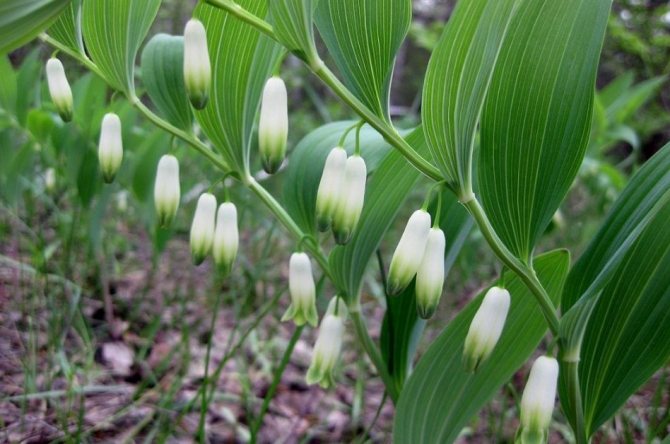

Whorled
The plant is 30-60 cm tall. The stem is thin, green, growing vertically. The leaves are xiphoid, light green. In length they reach 17 cm, and in width - about 2 cm. Young leaves, located at the bottom, grow alternately, and the upper ones are placed in whorls of 4–8 pieces. White oblong flowers are formed on inclined peduncles. The buds open in the middle of summer.
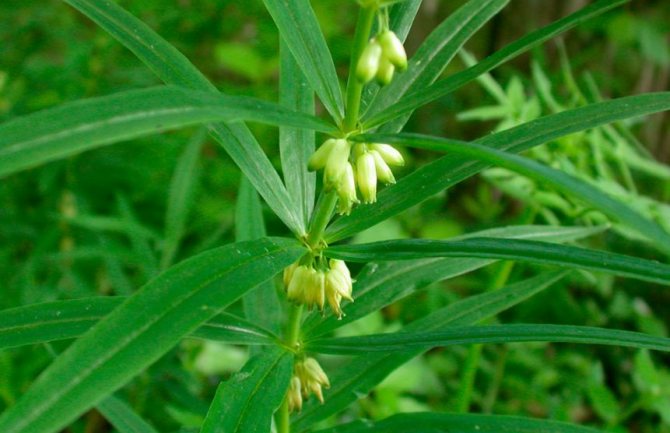

Multi-flowered
The type of multiflorous kupena is a plant up to 1 m high... The stem is arched, green. On the upper part there are rounded leaves. From the whorls in the leaf axils, 5-6 white buds appear, which open in July. The flowers hang gracefully on thin peduncles. Fruiting occurs in August.
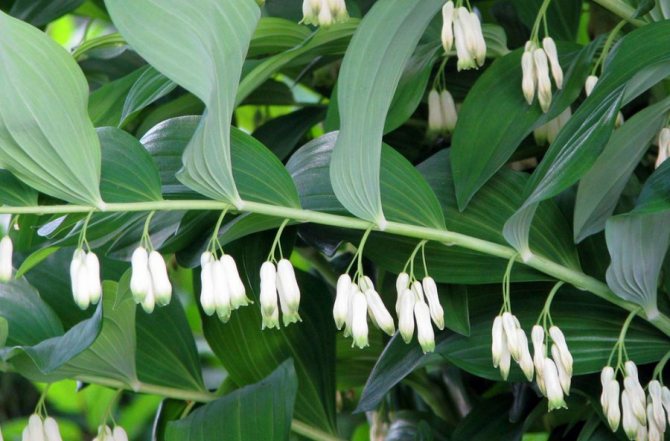

Broadleaf
The species is drought tolerant and can grow widely even on stony soils. The plant is up to 50 cm high and has a long rhizome. Wide, pointed at the ends of the leaves are placed on the stem alternately. White fragrant flowers are found in deciduous axils in pairs. The broad-leaved kupena blooms at the end of May for two weeks.
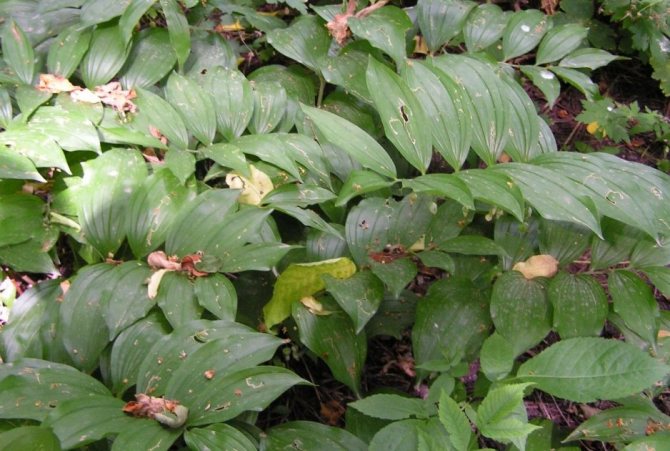

Squat, or low
A low-growing plant that grows up to 30 cm. Stems and leaves form dense thickets, grows slowly. Leaves are light green, alternately arranged on the stem. The flowers are large, white-green in color. Squat kupen are grown in rockeries.
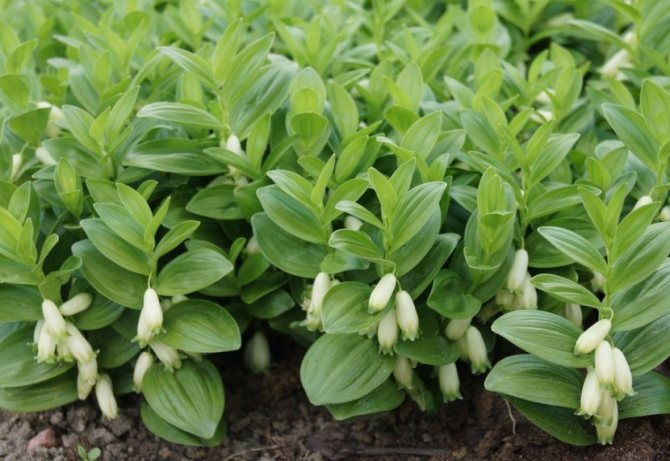

Hooker
The flower is 2.5–5 cm high. The stem is smooth, green. The leaves are straight and smooth: the upper ones grow in parallel, the lower ones alternately. The leaves are 3.5 cm long and 0.6 cm wide. The short pedicels are vertical. Flowers are purple, tubular, solitary. Flowering occurs in May. Plants grow densely, forming extensive thickets. Experts recommend Hooker for growing on rocky ground.
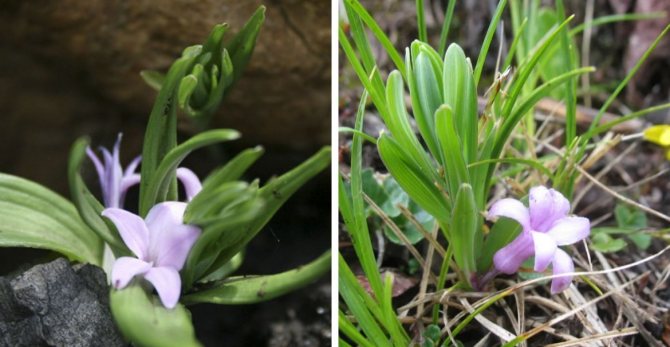

Pratt
A graceful plant, covered with pale purple bells, collected in whorled brushes. The leaves are xiphoid, elongated, painted in a peculiar greenish-silver color, are in whorls of 4–6 pieces. The length of the leaves is 15 cm, the width is 1-2 cm. The stems are dark purple up to 50 cm high. The flowers are twisted, grow in deciduous axils in pairs (2 pcs.). Habitat - deciduous forests. Flowering begins between May and June. The plant bears fruit with scarlet berries.


Planting and caring for the bunk
To grow a bathtub in your garden, you need to familiarize yourself with the planting rules and care requirements. Next, you should study in more detail how to plant a flower and take care of it in the future.
Main steps:
- choice of location;
- landing;
- watering;
- fertilizer;
- preparing the plant for the winter period.
Did you know? Another name for the kupena is "Solomon's seal". According to legend, King Solomon, having studied the medicinal properties of the plant, branded its root with his seal - a kind of "quality mark".
Seat selection
Kupena grows well in shady areas. Tall varieties can be planted in open sunny areas, but in this case the flowers will develop worse and grow slowly.When choosing a place for landing, it is important to take into account that the purchase grows for 12-15 years and does not tolerate a transplant. Consequently, it will constantly grow in one place.
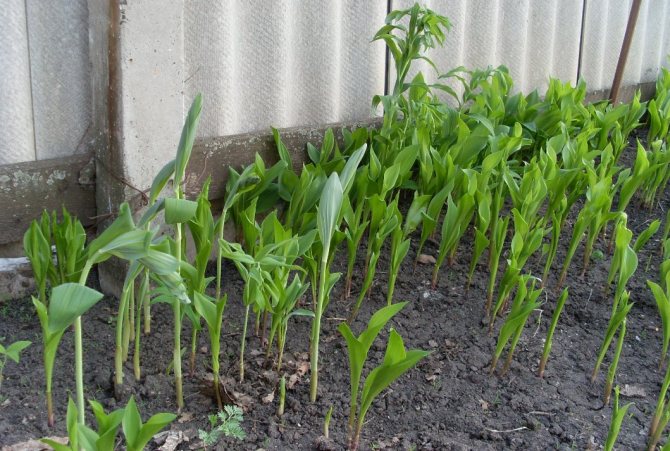

It is also necessary to pay attention that the flower does not react well to the accumulation of moisture in the soil., therefore, it is advisable to plant it on sites with deep groundwater. If the area where the flower will grow is selected correctly, then further care will require minimal effort.
We suggest that you familiarize yourself with the description of fine-toothed primrose.
Step-by-step landing instructions
Before planting, it is necessary to prepare the selected area in advance by removing weeds and grass, as well as digging up the area. Then you need to prepare the seedlings by removing them from the container along with the earthen clod. Then you can start planting.
Landing scheme:
- Fertilize the soil with compost and wood ash in equal parts, loosen it. Heavy soil can be thinned with sand and fine gravel.
- To deepen the seedlings by 15 cm.At the same time, it is necessary to maintain a distance between them of at least 20 cm.
- Sprinkle with earth and pour 5-6 liters of water.
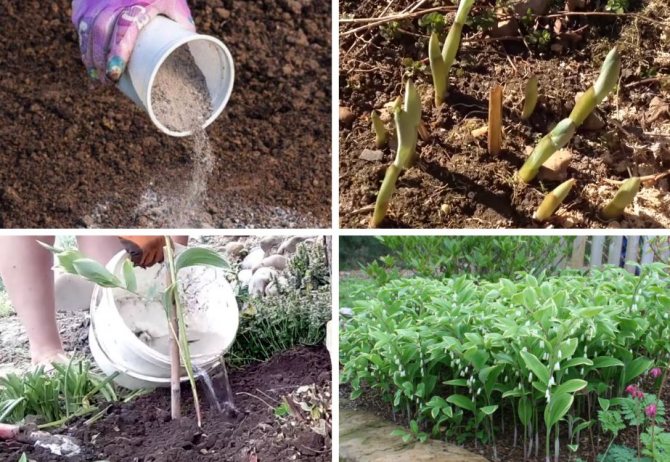

Watering
Kupena is extremely unpretentious in care. Since this plant is usually planted in the shade, abundant watering is not required. Watering should be done in moderation and only in the hot season, pouring up to 4-5 liters of water under one flower. The rest of the time (winter, spring, autumn), the plant will have enough natural precipitation. It is not recommended to loosen the soil after moistening, as there is a risk of damaging the roots that are located close to the surface.
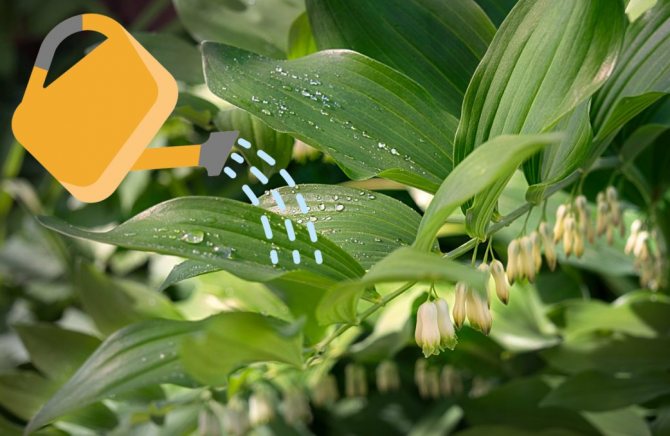

Fertilizer
Since all the necessary mineral and nutrients were introduced into the soil during planting, the kupen should be fertilized no more than once a year. DFor this, in the spring, it is necessary to apply top dressing to the soil, consisting of compost or manure (about one handful of organic matter per flower).
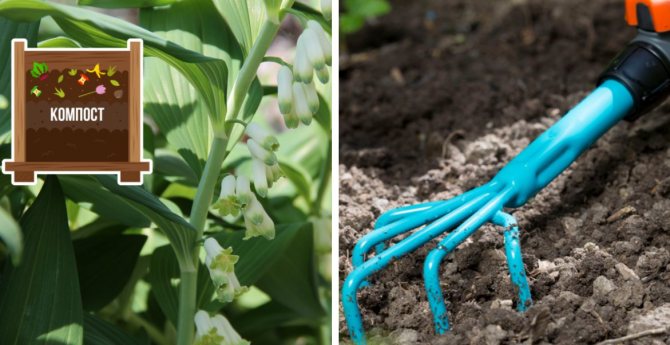

Soil care comes down to mulching and getting rid of weeds. Mulch is used to protect the soil surface from the formation of a poorly permeable crust. To do this, you can lay a small layer, about 5 cm, of leaves and chips around the flower. Weeds should be pulled out of the ground, but not weeded, as this procedure can injure the root system.
Wintering
Preparing for winter includes seasonal pruning... It is carried out in the fall, removing all the stems. As a result, only stumps should remain. In the spring, when the snow melts, young greenery will grow rapidly. Shelter from the cold is not required, since the kupena is able to withstand even the most severe frosts.
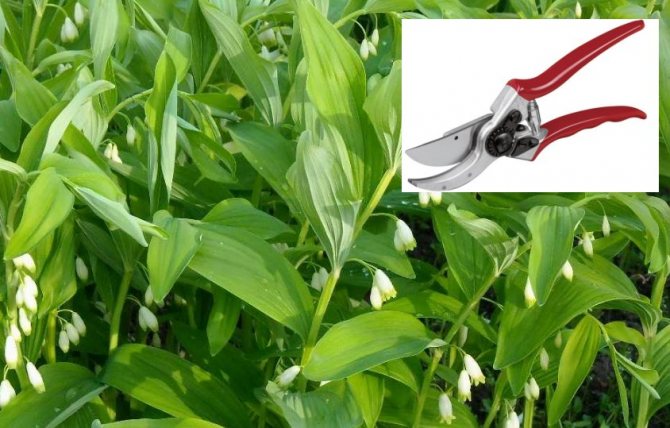

Contraindications
Attention! A plant without heat treatment is poisonous, it is dangerous to prescribe dosages and establish a course of treatment on your own.
It is not recommended to use Kupena:
- people suffering from contact, drug or seasonal allergies;
- for children under 16 years of age, pregnant women and during the period of breastfeeding, the use of Kupena for medicinal purposes is strictly prohibited.
Important: if negative reactions appear (itching, choking, rash, sneezing), stop contact with the plant. The help of an allergist is needed (therapy with antihistamines).
Reproduction methods
Kupena is usually planted in rows, several copies. In order not to purchase a large amount of planting material in the store, the plant can be propagated independently at home. A detailed description of each method follows.
Breeding methods:
- seeds;
- dividing the bush.
Did you know? In Tibet, it is believed that decoctions and preparations prepared on the basis of a pharmacy purchase contribute to longevity.
Seeds
Seed propagation of kupena is considered the most time consuming and time consuming. However, this method allows you to get multiple instances at once. It is necessary to plant seedlings in open ground in the spring. The flowering of the kupena planted in this way will begin only after 3-5 years.
You can propagate a flower by seeds as follows:
- Gather ripe berries and remove seeds from them.
- Fill a shallow box with a soil mixture of peat and sand (1: 1).
- Sow seeds in prepared soil.
- Place the container in the refrigerator and store there at a temperature of + 2 ° C. Under these conditions, the seeds will stratify within 3-4 months.
- Put the box with plantings in a warm place for another three months.
- Then put it back in the refrigerator for about 3-4 months. During this time, seed germination will begin.
- After stratification, the container should be stored in a well-lit place at a temperature of + 20 ° C.
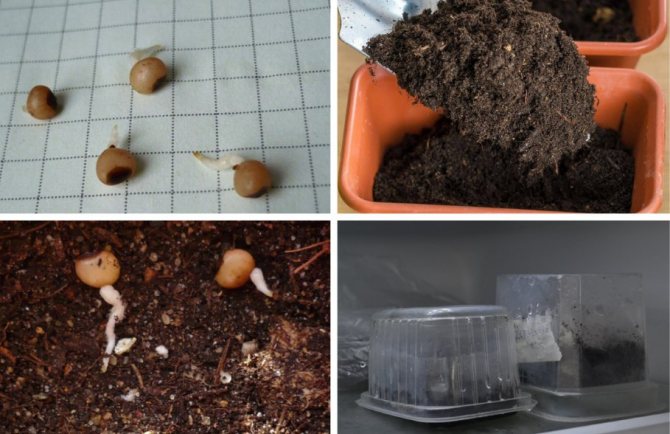

Dividing the bush
This method involves reproduction by segments of rhizomes, and is considered the most preferable, since rooting occurs rather quickly, and the appearance of young shoots begins already in the next season. So, in order to multiply the kupen by division, you need to dig it out of the ground and carefully divide the root into several parts. At the same time, it is important to ensure that there are growth points on each part - the so-called seals. Then the resulting fragments must be immediately placed in open ground and watered. It is not necessary to irrigate too abundantly, it is enough to pour 3-4 liters of water on each plant.
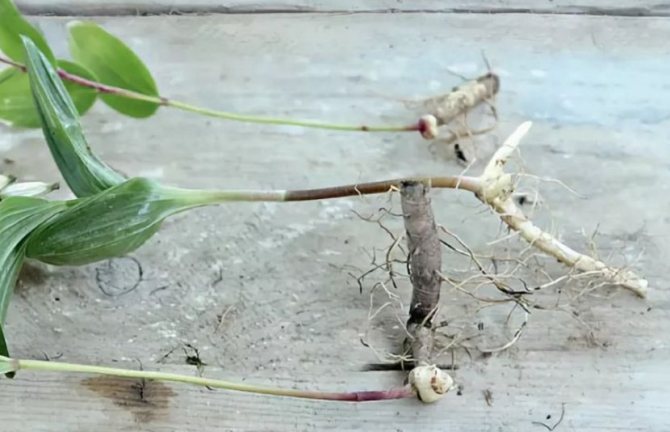

Combination with other plants
Kupena flower goes well with daylilies and irises. It is also often planted in flower beds with tulips to hide their swelling. The flower adjoins well with all plants that feel great in partial shade. These include:
- ferns;
- dicenter;
- hellebores.
Saxifrage - planting and care in the open field, in the garden, at home
With all the flowers listed above, as well as variegated plants, the multi-flowered one will perfectly coexist.
Note! If you do not divide the rhizome every few years and do not keep the kupena under control, then it will actively develop and displace the neighbors in the flower garden.
Kupena in landscape design
In any garden or flower garden, the decorative thickets formed by the bought will be welcome guests. It is thanks to them that unsightly and empty areas can be hidden, making the place attractive and cozy. Often the flower is used for planting trees near the trunk circles.


Garden lily of the valley in landscape design
It is impossible to miscalculate using a garden lily of the valley in landscape design. The plant, even after flowering, will maintain the composition thanks to the green gracefully curved leaves. Often, gardeners will plant a flower along the hedges.
Note! An attractive multi-flowered bush looks in cut, so it is often used to create bouquets and flower arrangements.
Healing properties
Kupena is considered a medicinal plant. All parts of it have a healing effect. In particular, the rhizome and shoots have anti-inflammatory, antiseptic, analgesic and expectorant properties. In addition, due to the beneficial composition of the plant, preparations prepared on its basis help stop bleeding. The plant as a medicine is used only within the framework of traditional medicine.
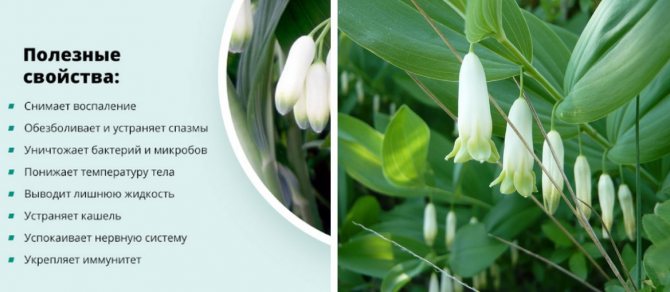

The use of tincture of kupena
For the manufacture of tinctures and decoctions, a pharmacy or multi-flowered one is used. Tinctures from the roots are used to treat bronchitis, stomach and duodenal ulcers, hemorrhoids. Compresses based on it are used to restore blood circulation in case of hematomas and bruises. Decoctions help get rid of freckles and acne on the face. Tinctures are used internally for migraines, heart failure, and for the treatment of gout.
Important! An overdose of Kupena tincture can lead to food poisoning. It is important to accurately dose the use of the product.
To prepare a medication for external use, you need to boil 50 g of grated rhizomes bought in 0.5 liters of water. Then insist for four hours and strain. It should be used with extreme caution, as the drug can cause burns on the skin.
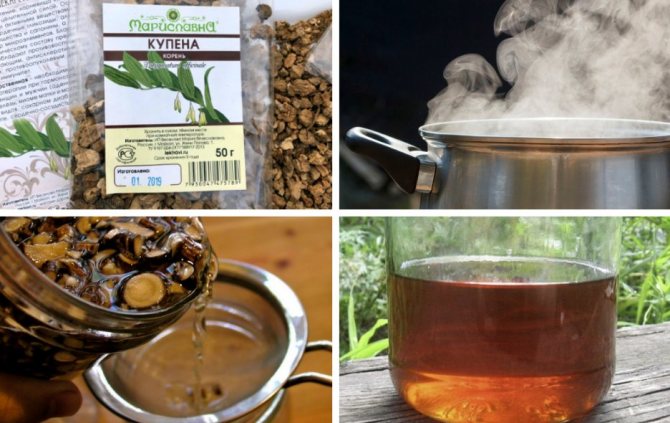

For internal use, you can prepare an infusion. To do this, pour 20 g of crushed rhizomes with 200 ml of water and cook. Then leave for four hours and drain. Take 1 tbsp. l. 3-4 times a day. The berries are consumed orally in order to provoke vomiting in case of poisoning.
Unique facts
According to legend, King Solomon himself liked this exquisite plant so much that he marked it with his seal. Since then, it has become customary to call the miraculous herb the Solomon's seal.
In the old days, young ladies, in order to acquire a natural blush, rubbed their cheeks with berries or root shoots.
From time immemorial, domestic animals were treated with kupena rhizomes baked in ash. The ointment saved livestock from the gadfly, destroyed the larvae of parasites, relieved itching, relieved inflammation and excruciating pain.
For Altai marals and Kupena deer, just like Lily of the valley is a favorite delicacy.
Pests and diseases
The plant has strong immunity and high resistance to diseases and pests. However, slugs can grow in dense thickets. Their appearance is due to dampness and shade, which is formed by thickened leaves. You can get rid of parasites by simply collecting them from stems and leaves. For prevention, you need to cover the ground under the flowers with a layer of wood ash (about 5 cm) and fragments of eggshell.
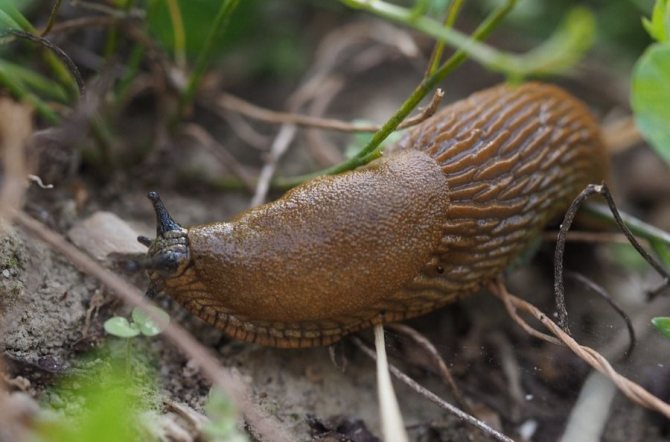

The dense growth of the Kupena hides unsightly tracts of land in the garden and looks great in the shade of trees. Considering that the plant is extremely unpretentious to care for, it will not be difficult to grow it. The rhizomes of the flower can be used as folk remedies, but only after consulting your doctor.


